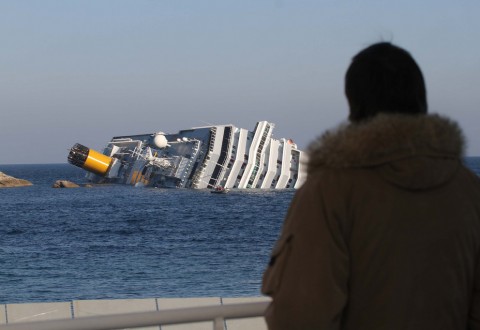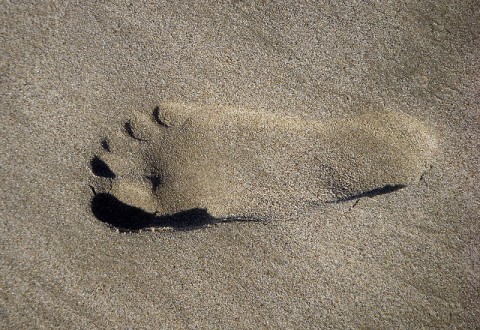The Costa Concordia is a ticking time bomb. The ship lying on its side, vulnerable to harsh waters and the elements, could potentially leak dangerous oil into the ocean at any moment. This is not the kind of oil that you put in your car but the cheap grade, thick, mucky kind that is similar to tar. Luckily, a Dutch salvage company is set to attempt extraction of the near 2,400 tons of oil from its 23 vessels starting this Saturday. This will prove to be a tough task but it’s certainly one that needs to happen immediatly.
Divers will blast several holes in the ship to be able to reach the more difficult oil tanks on the inside. If something goes wrong during this process this could easily be the most tragic environmental disaster in Italy since the Amaco Milford Haven back in 1991 that caught fire and sank to the ocean floor. The Amaco contained 1 million barrels of crude oil and heavily contaminated the Mediterranean coast and shorelines (particularly in France and Genoa) for nearly 12 years.
The Concordia has already claimed 16 lives and is alleged to be at the hands of an irresponsible cruise ship captain. On that day of January 13, 2012 Captain Francesco Schettino was said to have acted carelessly for abandoning ship and has been painted by crew in the past that he is “like a dare devil driving a Ferrari.” On that night, he had steered the ship too close to the rocky coastline to pay a salute to a general that was on shore. Nearly right after the ship cascaded into the rocky terrain, the nightmare began for the thousands onboard.
As many understand it (from watching movies or what have you), the captain is supposed to be the last to leave the ship during a disastorous situation. Transcripts show that he was ordered to stay aboard by Coast officials. According to the captain, he tripped and fell into a lifeboat. Others speculate he was scared for his own life and deliberatly stepped onto the life raft when he knew there were thousands that were still in need of help on board. He is now currently under investigation for causing the wreck and abandoning ship
The ship contained about 4,200 passengers and crewmembers. One passenger said that as soon as the ship took to the water the song from Titanic was playing. Just like in the epic romantic disaster film, a beautiful evening of music and dinner with friends and family turned into a scene where people were clutching to their life vests scared for their lives. Frightened and screaming passengers scrambled to board lifeboats. Women clutched to their children as they were eager to get on the rafts. This was a nightmare for everyone that boarded the Costa Concordia that night.
As the horrific scene of a partly sunken ship plays out on the nightly news, America sits back and watches with anxiety and horror. It puts a spotlight on the cruise line industry and people are beginning to question its friendliness and safety. With popular cruise vacations available at an affordable price it is no wonder thousands want to experience the lavish attractions that the “floating city,” has to offer. Ships like the Carnival bring millions of dollars to cities like Seattle and Washington where the ship docks. Aside from economic stimulation, comes a nasty truth about cruise ships. They are huge contributing factors to environmental pollution. According to the Daily Green, the Environmental Protection Agency reports that in one day a typical cruise ship generates:
- 21,000 gallons of sewage
- One ton of garbage
- 170,000 gallons of wastewater from sinks, showers and laundry
- More than 25 pounds of batteries, fluorescent lights, medical wastes and expired chemicals
- Up to 6,400 gallons of oily bilge water from engines
- Four plastic bottles per passenger – about 8,500 bottles per day for the Carnival Spirit
Friends of the Earth (FOE), grades cruise lines with an environmental score card. They found that Holland America and Norwegian cruise lines were recognized as the most in compliance with environmental standards and were both graded a B. and If you are interested in taking a “green” cruise vacation than you might also consider the Disney Cruise line which rose from a score card grade F in 2009 to a grade C in 2010 for upgrading to an advanced wastewater system.
With a travesty as grand as this one, cruise ship companies and regulators alike should note that environmental impact should be avoided wherever they see fit, which according to the statistics, seems to be everywhere. Improved safety precautions and better stringent laws should be put in place to avoid problems like these in future.
Right now Italian officials and emergency maritime crew are left the huge task of avoiding the destruction of Europe’s biggest marine sanctuary. The surroundings of the Tuscan island are home to 700 species flora and fauna, which includes dolphins, turtles, and seals. With the unpredictability of the ship, workers need to act quickly. This extraction also known as “hot tapping” will involve the help of over 100 volunteers and is said to take nearly 28 days to complete. If all goes well during the this 28 day process, then precious marine life and the delicate eco system of the shores dodged a huge bullet. Unfortunately, the same cannot be said for the 16 people whose lives were taken.
Hopefully we have learned from accidents like the oil tanker that caught fire in 1991 and even the infamous luxury liner Titanic that sank to the depths of the Atlantic Ocean in 1912. From exactly a century until now, we have come a long way. Let us just hope that this tragic event in Italy will not mark the next big environmental disaster for our planet earth.
Photo Credit: Some rights reserved by Falto Quotidiano via Flickr.




